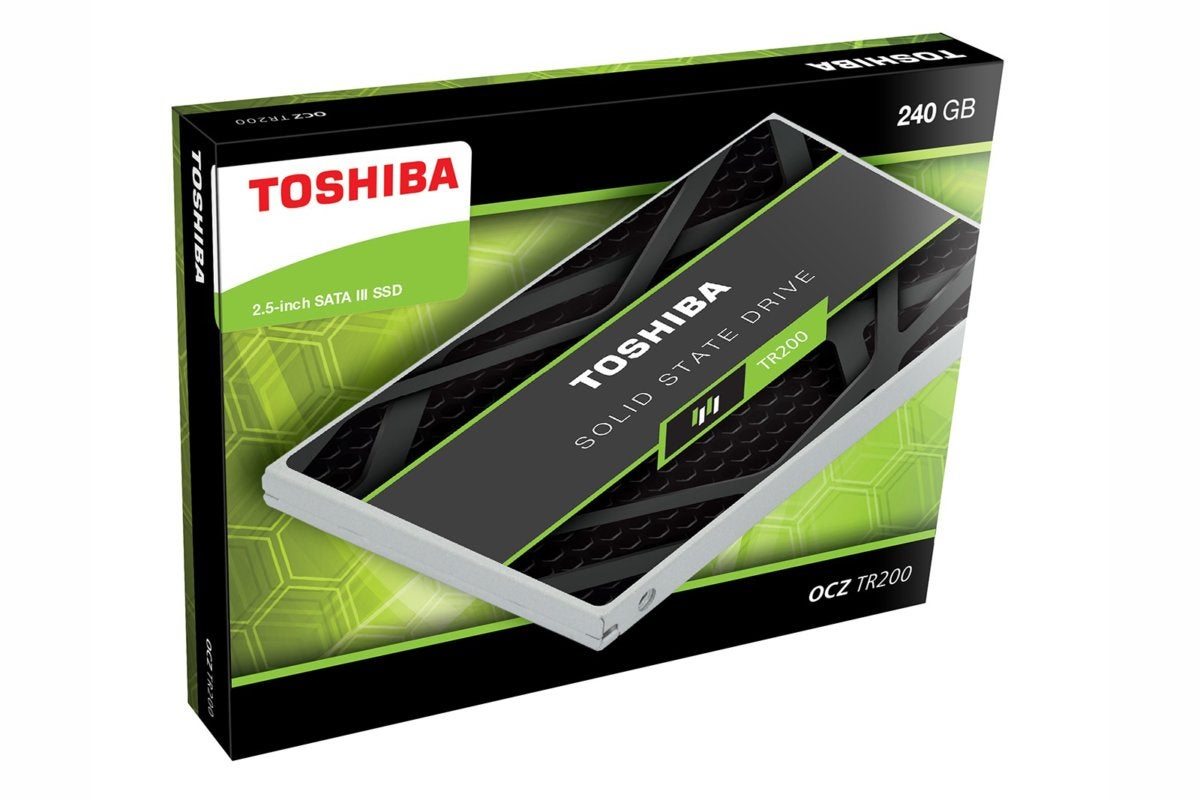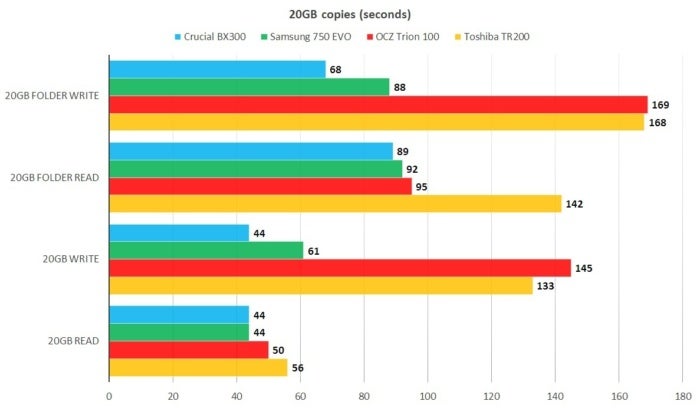Toshiba TR200 review: Another slow TLC SSD - mannbrose2001

Toshiba
At a Glance
Proficient's Rating
Pros
- Relatively affordable
- Good alight-duty operation
Cons
- Slower than a Winchester drive writing larger data sets
Our Finding of fact
Though this drive will behave like a normal SSD under light duty, write any substantial total of data to it and IT is slower than a hard drive. With no price advantage over much faster drives, the TR200 is not a product we recommend.
Advisable Prices Today
The integral idea behind Triple-Level Cell (3-bit/Tender loving care) NAND is to put much squeeze into less space for less cash. It's succeeded at the former, but the little hard currency affair hasn't very worked out. TLC drives are usable in larger capacities (up to 2TB), but are marginally cheaper than MLC drives at best.
But the biggest issue has been speed. When TLC drives were first introduced, sustained write performance on some was slower than a hard drive's, and not a particularly fast hard drive. Thankfully, civilized caching and tiering with faster SLC and MLC (actually TLC treated as that) has largely remedied that.
Unhappily, the cure hasn't benefited Toshiba's other TR200. Not since the Toshiba/OCZ Trion 100 have we seen a drive this slow with large data sets, writing them slower than most hard drives. And this from a accompany that's the OEM for NVMe SSDs so much American Samoa the XG5, which reads at over 3GBps and writes at over 2GBps. Go down figure.
Note: This reappraisal is component of our go-to-meeting SSDs roundup. Go on that point for inside information about competing products and how we tested them.
Specs, design and price
The TR200 is a SATA 6Gbps, 7mm thick drive that uses 15nm, 64-layer BiCS (Bits in Newspaper column Stacked) TLC NAND, much commonly known as 3D NAND. The drive likewise features a superlow 1.6-watt power white plague rate, which is an advantage if you want to increase laptop run time. We too quite like the green-and-black color system, which is a vast improvement visually over Toshiba's older (but much faster) Q300 with its generic wine silver gray looks. It seems Toshiba has taken a cue from OCZ on at least some matters.
 Toshiba
Toshiba As jolly as the box looks, IT hides truly poor sustained pen performance, and really slow small filing cabinet read performance.
The TR200 ships in 240GB, 480GB (the size up we tested), and 960GB capacities for $90, $150, and $290, respectively. That's around 30 cents per gigabyte, the same cost as the majority of the budget contender. Toshiba warranties the TR200 for 3 years, and rates it for 60TBW (TerraBytes Written—the total amount of authorship the drive is capable of) for every 240GB. That's certainly not the most generous rating we've seen, but most SSDs should in reality last quite bit longer, and 60TBW per 240GB is credibly much ten eld' worth of writes for the moderate user.
Public presentation, or lack thereof
If you never wrote many than approximately 5GB to 10GB of data, you might never notice that the TR200 is slow. Until that point, it ISN't, with the fast random access and 500MBps read/writes that are the hallmark of all modern SATA SSDs. If that fits your utilization scenario (Windows, browsing, email, and light stage business tasks) you can break loose with the TR200.
But the drive slows depressed to around 100MBps after you exceed the amount of cache provided. That seemed to glucinium around 1.5 pct of total mental ability, or 5GB-7GB on the 480GB pose we tried and true. Away way of comparison, there are SATA hard drives such Eastern Samoa Seagate's Barracuda Pro 12TB that drop a line at 250MBps, and USB 3.0 hard drives generally write at 100MBps to 120MBps.
Back to it visible radiation-usage scenario: If you ran AS SSD's 1GB test you'd get what look care normal SSD numbers. Run the 10GB exam, as we did, and you get the disturbing numbers you construe below.
 IDG
IDG The 480GB TR200 testament dribble to 100MBps authorship and stay in that respect if you write more than 5GB. The above includes penning to the faster cache memory, hence the 200MBps intermediate.
 IDG
IDG Read 'mut and cry. The TR200 is fundamentally the slowest SSD we've ever so tested, rivaled only by the OCZ Trion 100—some other drive made aside Toshiba.
The TR200 proved even slower than the historically slothful OCZ/Toshiba Trion 100 by virtue of a slower performance reading our 20GB mix of files and folders. If you're cloning an existing drive to a TR200, you'rhenium in for a sesquipedalian hold off.
Hate to say it, just…
It's sobering to think that a don't-buy recommendation for the Toshiba TR200, which is what we'atomic number 75 advising, could crusade people to lose their jobs. Toshiba today has the uncertain distinction of forcing us into the no-buy zone twice. We wish to heck they'd stop.
If the TR200 were fractional, or even ii-thirds the terms of other drives, information technology power be a different story. If you find it for that, it will provide the bulk of the hard-drive-to-SSD upgrade experience. Simply we can't recommend buying a beat back that will yet disappoint you, when for the comparable Leontyne Price you toilet buy one that North Korean won't.
Soh, in plain language: Don't buy the TR200, and don't buy the Trion series they put out below OCZ's label. Instead look to Crucial's BX300 or Sandisk's Immoderate 3D. And here's hoping Toshiba gets its number together.
Best Prices Today
Note: When you purchase something after clicking links in our articles, we may earn a small commissioning. Read our affiliate link policy for more inside information.
Jon is a Juilliard-trained instrumentalist, quondam x86/6800 programmer, and monthlong-time (New 70s) computer enthusiast people in the San Francisco bay region. jjacobi@pcworld.com
Source: https://www.pcworld.com/article/407471/toshiba-tr200-review.html
Posted by: mannbrose2001.blogspot.com


0 Response to "Toshiba TR200 review: Another slow TLC SSD - mannbrose2001"
Post a Comment